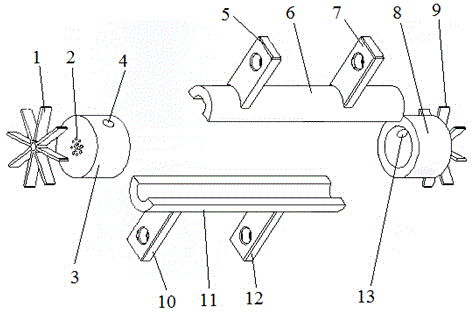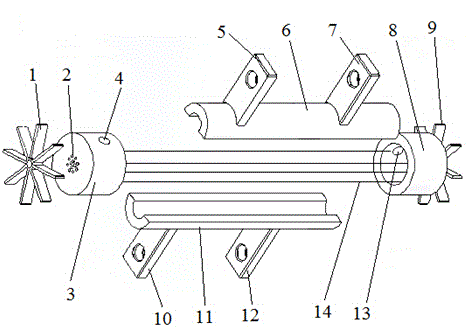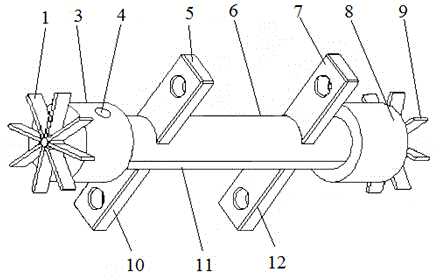Multi-channel nerve repair conduit with tissue induced function and mold
A nerve repair and inductive technology, applied in the medical field, can solve problems such as easy inactivation, influence on nerve regeneration, and differences in biocompatibility, and achieve good degradability and biocompatibility, repair peripheral nerve defects, and mechanical strength Guaranteed effect
- Summary
- Abstract
- Description
- Claims
- Application Information
AI Technical Summary
Problems solved by technology
Method used
Image
Examples
Embodiment 1
[0071] According to the mass ratio of 1:5, salidroside and chitosan were respectively taken, mixed uniformly, and chitosan-coated salidroside microspheres were prepared by using the tripolyphosphate method; the microspheres were treated with 1% genipin Cross-link at 37°C for 1 hour, freeze-dry in vacuum for later use; dissolve polylactic acid-polyglycolic acid copolymer in chloroform to obtain a saturated solution, add 10 mg of the prepared microspheres, stir with a magnetic stirrer at 50 rpm for 2 hours, and place in a fume hood Remove chloroform by volatilization, centrifuge at 4°C and 15,000rpm for 10 minutes, add appropriate amount of distilled water to disperse to obtain composite salidroside sustained-release microspheres, dry at room temperature for later use; use light microscope, laser particle size analyzer and scanning electron microscope to evaluate composite rhodiola respectively Morphology, particle size characteristics and characterization of glucoside sustained-...
Embodiment 2
[0073]According to the mass ratio of 1:10, salidroside and chitosan were respectively taken, mixed evenly, and chitosan-coated salidroside microspheres were prepared by using the tripolyphosphate method; the microspheres were treated with 1% genipin Cross-link at 37°C for 1 hour, vacuum freeze-dry for later use; dissolve polylactic acid-polyglycolic acid copolymer in chloroform to obtain a saturated solution, add 10 mg of the prepared microspheres, stir with a magnetic stirrer at 60 rpm for 2 hours, and place in a fume hood Remove chloroform in the medium, centrifuge at 4°C and 15000rpm for 10min, add appropriate amount of distilled water to disperse to obtain composite salidroside sustained-release microspheres, dry at room temperature for later use; use light microscope, laser particle size analyzer and scanning electron microscope to evaluate composite rhodiola respectively Morphology, particle size characteristics and characterization of glucoside sustained-release microsph...
Embodiment 3
[0075] According to the mass ratio of 1:50, salidroside and chitosan were respectively taken, mixed evenly, and chitosan-coated salidroside microspheres were prepared by using the tripolyphosphate method; the microspheres were treated with 1% genipin Cross-link at 37°C for 1 hour, vacuum freeze-dry for later use; dissolve polylactic acid-polyglycolic acid copolymer in chloroform to obtain a saturated solution, add 10 mg of microspheres, stir with a magnetic stirrer at 55 rpm for 2 hours, and volatilize in a fume hood Remove chloroform, centrifuge at 4°C and 15,000 rpm for 10 minutes at high speed, add appropriate amount of distilled water to disperse to obtain composite salidroside sustained-release microspheres, dry at room temperature for later use; use light microscope, laser particle size analyzer and scanning electron microscope to evaluate composite rhodiola Morphology, particle size characteristics and characterization of glucoside sustained-release microspheres; in vitr...
PUM
 Login to View More
Login to View More Abstract
Description
Claims
Application Information
 Login to View More
Login to View More - R&D Engineer
- R&D Manager
- IP Professional
- Industry Leading Data Capabilities
- Powerful AI technology
- Patent DNA Extraction
Browse by: Latest US Patents, China's latest patents, Technical Efficacy Thesaurus, Application Domain, Technology Topic, Popular Technical Reports.
© 2024 PatSnap. All rights reserved.Legal|Privacy policy|Modern Slavery Act Transparency Statement|Sitemap|About US| Contact US: help@patsnap.com










